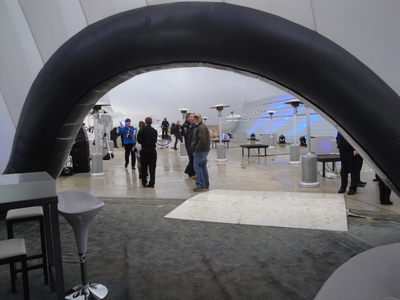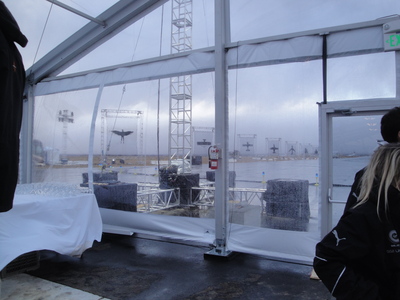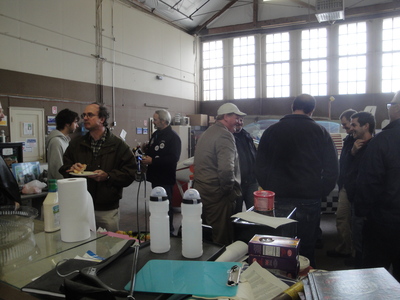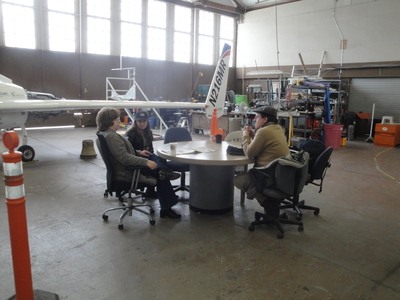Just in time for the Season of Festive Cheer, The Times (of London) reminds us all again of what is likely to be the biggest foreign policy issue for the next few years. There appears little likelihood that a future possible Conservative administration will have much of an idea of what to do about it, and of course we have a Nobel Prizewinning Chicago-machine politician in the White House. Not an encouraging state of affairs.
|
|||||
|
I yesterday went shopping for an LCD television for a friend of mine. I went to Richer sounds (a splendid and rather uncharacteristic British retailer known for selling high quality electronic merchandise at low prices from relatively unfashionable locations where the rent is low, providing fine customer service and treating employees well), and I ended up buying a Sharp TV. Interesting company, Sharp. People sometimes think the name is a little odd. For what it is worth, the company originally made mechanical pencils for engineering purposes, and they wanted to make it clear that they were very sharp (true story). Japanese companies seem to divide into two kinds. There were pre-WWII monoliths – the so called zaibatsus. American policy after the war was that these were far too powerful and that they were to be broken up into smaller companies. This American policy failed. They zaibatsus were theoretically broken up into smaller units, but they retained a complex arrangement of holding companies and cross shareholdings in which management control largely remained in place even though the companies had theoretically been split up. They evolved into post war industrial groupings known as keiretsus. These companies remained politically well connected, and when Japan attempted to grow its exports through government directed industrial policy, these were the beneficiaries of it. These keiretsus included Mitsui/Toshiba, Mitsubishi, Hitachi, Matsushita (Panasonic), and others. As I said, these well connected companies were recipients of government largesse, and those who would wish to praise government industrial policy would tend to construct a story that this led to Japan’s industrial success in the 1970s and the 1980s. But of course, the story is more complex than this, There is a really good book about this, We Were Burning: Japanese Entrepreneurs and the Forging of the Electronic Age by Bob Johnstone. The interesting part of the story is that although the keiretsus did benefit from the growth of the Japanese electronic industry, they were not where its innovation came from. The companies that were the heroes in this regard were small, non-existent or unfashionable in 1945, or were discarded or disdained pieces of broken zaibatsus, In particular, we are talking companies like Seiko-Epson, Canon, Yamaha, or even Sanyo or Honda or Suzuki (the Japanese government tried to micromanage the car industry, but the motorcycle industry was seen as less interesting, and so that is where the interesting companies ended up coming from). In electronics, in the 1970s, Sharp’s research was led by Sasaki Tadashi, whose enthusiasm earned him the truly glorious nickname of “Dr Rocket” – personally I would almost kill for such. In that era Sharp pretty much invented the electronic calculator and the LCD display. Sharp remains a leader in LCD display technology to this day. To the extent, that in this day of LCD television, Sharp is the only Japanese company worth mentioning in this market. Sony – a company that rode a totally unique route between the keiretsu and the post war upstart, but which in the end did a better job of selling itself as a brand than an innovator – was the undoubted leader in the era of CRT televisions, but (perhaps as a consequence) totally missed the transition to flat screens. A lot of fancy televisions are sold today under the Sony brandname, but these were generally actually made by Samsung, or (in certain high end cases) by Sharp. The only Japanese company that actually makes televisions today is Sharp. The company that always was the great innovator: the company that Sony pretended to be. Which is why I was happy to buy such a set for my friend. It’s not enough to be rich and famous if you’re not somehow “relevant”. Whether it’s Prince Charles or Al Gore or Leonardo DiCaprio or any of these other guys, they all have the same message: “Hey, I deserve to live like this. Now shut up and shiver in the dark, you peasants”. I had planned on visiting the Masten Aerospace hanger as well, but as we ran into Dave at XCOR I got business out of the way and did not really have an excuse to sandwich that much desired visit into our schedule. Time had slipped by far too rapidly and Rand was due at the Mariah Hotel to get his Press credentials. Since I was also doing articles and had not yet had any guarantee of getting into the event as I was still just wait listed, I chanced showing up at the press desk, egged on by some Press friends. It did not work and in fact a woman named Jackie looked like she was about to turf me out of the building on my ear and thereafter seemed to glare at me every time she saw me. My main chance at getting in was more official and as it turned out, it was successful. After Rand left on the press bus I tried the VIP desk. They were much more helpful and after showing a key email and talking with a few people in Virgin Galactic I was presented with one of the last of the stainless steel VIP badges and told to hurry on board the last bus.  The VIP registration desk. Photo: copyright Dale Amon, All Rights Reserved The busses were the only way onto the field and even they were held up waiting for obeisance to red tape. All the buses, whether from LA or the hotel, were held in a queue and all were released to the taxiway at once. The party site was at the end of the runway, hard up against the exhaust deflector and far from the hanger area. There were large signs which I correctly took to be part of the night time light show and a grouping of tents, one very large clear plastic covered structure and  The main tent. Photo: copyright Dale Amon, All Rights Reserved two smaller inflated balloon structures. It was all very 21st Century. 
Photo: copyright Dale Amon, All Rights Reserved Inside of the tents was the sort of environment you would expect from a party held by Richard Branson for a few hundred friends. The first tent held the coat and bag check and was the point at which we were given our very nice Puma ‘VirginGalactic’ jackets and ski caps.  OCST Director George Nield deep in a conversation inside the first balloon tent. Photo: copyright Dale Amon, All Rights Reserved The interiors of the two balloon tents were quite nice looking  Interior of second balloon tent. Photo: copyright Dale Amon, All Rights Reserved  The second balloon tent exits at the jet exhaust deflector. Photo: copyright Dale Amon, All Rights Reserved Outside the second tent I found a sculptress still at work carving a space-suited figure out of a block of ice. As it turned out one of the sponsors was Absolut and carved ice played a big part in the night’s festivities. I do suspect at the planning stage they did not think it would be so cold that there would be no melting to worry about.  It was in no danger of melting. Photo: copyright Dale Amon, All Rights Reserved There was another bar inside the main tent and then the main auditorium area. People were collecting there as the speeches were due to start soon. There were little knots of conversation as people made contacts of opportunity or met with old friends.  Virgin Galactic President Will Whitehorn. Photo: copyright Dale Amon, All Rights Reserved  The fellow in orange is Dick Rutan, the man who along with Jeanna Yeager flew the first non-stop flight around the world. Photo: copyright Dale Amon, All Rights Reserved  The global media were out in force. Note Peter Diamandis, founder of the X-Prize Foundation in the lower right. He is the man responsible for this explosion in commercial manned space flight. Photo: copyright Dale Amon, All Rights Reserved  Brett Silcox from NSS was busy chatting with targets of opportunity.. Photo: copyright Dale Amon, All Rights Reserved I walked around the tent to get a feel for the territory.  This is the tarmac area where I expected we would see SpaceShipTwo after dark. Photo: copyright Dale Amon, All Rights Reserved  The media were everywhere and interviewing everyone. Photo: copyright Dale Amon, All Rights Reserved There was a full scale replica of SpaceShipOne, the craft whose first flight I live blogged from here some five years ago.  The X-Prize Foundation arranged for the creation of replicas of SpaceShipOne. Photo: copyright Dale Amon, All Rights Reserved  The main stage was ready for occupation and speechifying. Photo: copyright Dale Amon, All Rights Reserved Tomorrow I will cover the speeches. This is the third in a series of articles. The previous one is here A few of my photos also appear in Rand Simberg’s Popular Mechanics article. There are armed, untouchable criminals at the US Border and we pay their wages. Within a few seconds of cranking up my computer this morning I was reading this posting by Steve McIntyre, which I got to via Bishop Hill, who says of it:
So that’s two links to the McIntyre posting in this already. The internet already contains a lot more. Watch it go viral, much as this just did. A commenter on McIntyre’s posting, Jonathan Fischoff, says:
Chris S says:
Indeed. What of Al Gore‘s other argument (beside the taken-out-of-context argument), that all these CRU emails are ten year’s old, so, really, what the flip? As thousands have already pointed out, many of the CRU emails, which Gore has clearly not read or even read very much about, are far more recent. But yes indeed, the emails scrutinised in this latest McIntyre posting do indeed go back a decade. But what that shows is: so does the scientific dishonesty. Gore is saying: “Relax, it goes back a long way, these guys have been conning us for a decade.” This doesn’t really work as a put-down, does it? Will “the media” give this McIntyre posting the attention it deserves? I am increasingly thinking that it doesn’t matter what these people say or don’t say about this story, or about anything else. McIntyre’s posting, one of the many fragments of this far bigger mega-story, is now out there, for anyone with internet access who wants to read it, and read about it. Tens of thousands of comments on it, attached directly to it, and such as this one that you are reading now, are even now being concocted, by and for all who care. Whether the old-school journos join in (Delingpole is a good example of that trend) and thereby become part of the new media, or prefer to keep looking away (see Delingpole’s excellent recent posting about the pathetic Climategate non-performance so far of Private Eye) this says more about their own future than it says about the story itself. As with the named and shamed CRU scientists, the exact motivation behind each particular item of old-school media deception, neglect or misdirection is a matter of debate. The fact of it is not, and any who want to can now see this. Michael J just emailed me this link to a piece by a scientist. The point is, guys like this can now can now say all this. He no longer needs any journo to open the door for him. After hanging out in the SSI office for awhile, Rand and I headed over to the XCOR hanger, the next after the Scaled Composites one shown here. I am sure caffeine was flowing like water inside as Scaled staff got everything ready to roll.  You could almost feel the coming buzz from the Scaled Composites hanger. Photo: copyright Dale Amon, All Rights Reserved We were let into XCOR through the front reception and found yet another crowd of which we knew practically everyone. It is not a big industry so practically everyone knows everyone else. Rand and I were there for business as well as saying hello. You know, just making sure people remember us when they suddenly have money and need someone to help spend it!  California does not yet require listing Rocket Scientists and Hanger Cats as potentially Hazardous Materials. Photo: copyright Dale Amon, All Rights Reserved XCOR was the host of the local get together. The crowd there traded thoughts on rocket engine design, control systems, who currently has money and who does not… all of the important things in life. Well, some of them at least. See how many people you can name from this crowd.  XCOR and Masten folk talking about rockets Photo: copyright Dale Amon, All Rights Reserved  XCOR and Masten folk talking about rockets Photo: copyright Dale Amon, All Rights Reserved I had a long chat and traded stories with Aleta Jackson who besides being one of the leading lights of XCOR is also someone I have known for…. well perhaps I should not say how long, but the light had definitely been separated from the dark by then.  Aleta has lots of good stories. Photo: copyright Dale Amon, All Rights Reserved There are bits and bobs of rocket planes, rocket engines and test gear all about the hanger the XCOR folk have called home for much of this decade, but the real eye-catchers are these beauties:  The Rocket Racer looks fast just sitting there. Photo: copyright Dale Amon, All Rights Reserved  And they have two of them sitting there! Photo: copyright Dale Amon, All Rights Reserved Aleta saw me drooling and smitten at the cockpit door and demanded I sit in it. On the serious side, the controls of this baby are pretty much what you would find in any General Aviation aircraft, although I suspect the glass cockpit part of it has a few other twists. At Alamogordo two years ago I heard they are to have a Heads Up Display to superimpose an image of the racing ‘gates’ on the external view. In any case, I got a brief ground stint in the left hand seat and held its throttle in my hand.  I will remember to ask Aleta for the keys next time. Photo: copyright Dale Amon, All Rights Reserved Part 1 of this series is here. The next article will show our intrepid rocket renegades making their tortuous way to the most historic party of the decade. My good friend Rob Fisher recently wrote the following on his own blog.
Yes, but Bob Geldof and Midge Ure wrote those lyrics, and they had this British preconception already. Another factor might be that the places in Africa that British people are most likely to visit are Egypt, Tunisia, Morocco and South Africa: the Sahara, and the arid south. There is plenty of fertile land in the middle. A tragedy is that some of the most fertile parts of Africa tend to be some of the most troubled: the vast Congo basin is prime land, essentially, and yet its history has been unspeakable, at least since the arrival of King Leopold’s privateers in 1877. As Chris Moyles discovered, Uganda is green and fertile, but its history is not the happiest either. People who attempt to raise awareness of malaria in Africa and elsewhere, and to raise money for its prevention deserve praise, of course, but what I am struck by is that the story about mobile phones becoming ubiquitous in poor countries has only just reached these people. This story is at least five years old now in the sense that most people have access to one and probably closer to ten in the sense that mobile phones existed in these countries and networks have been quite comprehensive, in many cases as comprehensive or more so than in rich countries. A related story: about three years ago I was walking along the Thames path on a Sunday afternoon. and I passed City Hall. Outside the building was some kind of “Here is how bad things are in the third world and why we should fell guilty” kind of exhibition provided for us by Ken Livingstone’s lackeys using our money. Amongst the factoids of information in this display was the statement that “90% of the world’s population have never made a phone call”. The “x% of the world’s population have never made a phone call” meme has been around for a while. 90% is obviously ridiculous and shows intense innumeracy from whoever made it up. (About 15% of the world’s population lives in rich countries, and if you add “rich parts of middle income countries, you can increase this number to 20 or 25%). The meme seems to usually be stated as “50% of the world’s population have never made a phone call”. Clay Shirky attempted to investigate where the meme came from, and the first recorded statement of it appears to be from engineer Greg LeVert of telephone company MCI in 1994. However, he said it in the context of “.. but oh boy is this going to change with all the great new technology that’s in the pipeline”. Nobody knows where he got the factoid from though: he may have just made it up. However, the Al Gores and Michael Moores and Kofi Annans and the like (and even people like Melinda Gates and Carly Fiorina who should know better) have repeated it endlessly since – or at least were doing so until only a few years ago. It is, of course, just not true. It is extraordinary that people should repeat out of context a ten year old view of what the poor world is like, as if the ten years between 1995 and 2005 were static in the development of telecommunications. At the time I encountered that exhibition outside City Hall, there were around 3 billion active mobile phones in the world: so therefore, although 90% of the world’s population had never made a phone call, about 50% of the world’s population owned a mobile phone. (They were all big texters, apparently). Since then, the number of mobiles in the world has increased by a further 50% to around 4.5 billion. The number of people with multiple phones per person or separate voice and data accounts and such has now reached the point where you cannot go directly from this to “4.5 billion people have mobile phones”, but the number of people who do is clearly greater than 50% of the world’s population. Given phones shared between families and friends, and the interesting third world concept of the cellular payphone, the percentage of the world’s population that is old enough to have made a phone call and has never done so must be in the low single figures. The use of this meme by the internationally prominent seems to have finally died over the last couple of years: even someone as dim as Al Gore can figure out from his occasional views out of windows of five star hotels or between the gaps between members of his entourage on his occasional trips to the third world that something has changed, I suspect. Finance and business folk get this completely and got it long ago: fortunes have already been made selling mobile phones to people in poor countries. But the well intentioned who seldom leave rich cities other than to visit Mediterranean beaches still don’t generally get it. At best, people who see Africa as a problem to be addressed through benevolence, charity and aid have made small differences in a few places. The capitalists who have built mobile phone networks have transformed the continent utterly. The logistical networks that go with them have facilitated all kinds of other changes, too, in terms of logistics and markets. All kinds of consumer goods are available that were not before. (Many people cannot afford them on an everyday basis, but they are there, and this matters). Just as in the west, food is better, and there is more variety. There are lots of under the radar small businesses that were not there before either. Access to information and to the outside world is much greater. As it happens, my first trip to Africa was to Kenya and Tanzania, and a main aim of that trip was to climb Kilimanjaro, too. → Continue reading: Mobile phones are only part of the story in Africa A number of governments – the UK and German – have used information stolen from a Liechtenstein bank in a bid to hunt after alleged tax evaders. And now, there is a story that data has been stolen from HSBC Private Bank (Suisse), divulging data on scores of French clients. The French government, you will not be surprised to learn, gentle reader, is probably not all that shy of using stolen material. It will be interesting to see what happens to such data. Here is another news report. As I keep saying in my defence of tax havens, bank secrecy is not really about allowing dodgy folk to squirrel away ill-gotten gains, which is the usual image presented these days. (That is not to say that such secrecy has not been abused in the past). In past ages, groups fleeing persecution – such as Jews from Nazi-controlled Europe – availed themselves of banking secrecy in order to protect what was left of that wealth. We should not be so naive as to imagine that even without a repeat of such horrors, there is not a need for client privacy to be rigorously enforced. It is monstrous that governments should use stolen material in this fashion, but then, as the founding editor of this site likes to remind us, the state is not your friend. Here is a witty description of the way the Climategate story is unfolding, from someone called David Solway:
Like David Solway, and like our own Johnathan Pearce, I am optimistic about how the Climategate story is unfolding. It will, hamster like, run and run. How many other climate scientists cooked their data, and how outrageously? Which politicians, and which journalists, took the lead in swallowing this story? Who has been paying all these climate scientists to find AGW by fair means or foul and then to recommend global statism? The questions are endless, the answers will be fascinating, and the dextrosphere won’t let go of this now. But what I want to know is: how does David Solway know all this, about how hamsters behave when set upon in a cage by a snake? His description is suspiciously vivid. Has he actually done this experiment? Has he seen hamsters in a cage being attacked by a big snake, on account of him having just put them there? If so, and if he then did nothing to rescue the poor hamsters, because science is more important than being nice to hamsters, then: what a complete bastard. The Climategate scientists put themselves into their cage, but this cage is only metaphorical and nor are their critics literally going to eat them, however much some of them might deserve such a fate. But David Solway’s actual hamsters did nothing to deserve such torment. He adds:
Oh, one feels for them, does one? But not enough, it would seem, for one actually to try to rescue them. Maybe David Solway just saw this on You-Tube. Or maybe he, or some equally nasty friend of his, set all this up personally, but then later, in the nick of time, he (or they) did rescue the hamsters (in which case David Solway is still a bastard but not as much of one). Either way, I think he should have said. He ends his piece thus:
It’s almost as if a friend of David Solway’s read everything above this ending, and said what I just said, isn’t it? As a description of Climategate this final reversal contradicts everything before it. “This too could happen.” How? An “indulgent hand”? What hand? The idea of such pieces is to raise the morale of David Solway’s side and mine in the Climategate argument. Keep it up lads, we’re winning. And then he goes and ends by saying, for no reason: but then again, maybe we’re not winning. Why do writers do this? Something to do with ending intriguingly and amusingly, perhaps, with a final and surprising U-turn that you did not see coming? Or maybe it’s a doomed attempt to mollify the unmollifiable opposition, an attempt to turn them into neutrals by being nice to them, an attempt to be inclusive, a friendly nod to all the people who aren’t reading in the first place. Or maybe David Solway just wasn’t sure that his piece is actually right, in which case I think his doubts would have been better handled by appearing at the start alongside his hypothesis, on a this-may-not-be-right-but-here’s-a-thought basis. Or, in this case, did he simply want to look less like a hamster-torturing bastard but forget that his way of trying to do this contradicts his entire argument? What I want to know is, were those actual hamsters actually rescued? Timothy Garton Ash, writing in the Guardian displays the jarring sensibilities that comes inevitability from holding the sort of fuzzy authoritarian statist views that prevail these days. On the subject of the Swiss ban on new minaret construction…
Actually it is about ‘urban planning’, just not for the sort of reasons the writer approves of. But what makes me laugh is that Ash has no problem whatsoever using the force of the state to make people build in ways he approves of. It is clearly axiomatic to him that the state gets to have planning regulations over what you can build on your own private property, even over mere aesthetic issues (i.e. he likes the fact the political trumps the social completely when it comes to your property). He just wants what people like him thinks is ‘desirable’ to be allowed. Yet somehow when that political process he accepts as axiomatic produces something he does not think is ‘desirable’ to his Guardianista sensibilities, I doubt it occur to him that maybe it is his acceptance of people exerting force backed political power over others in pretty much every aspect of life where the problem lies. Muslims in Switzerland wishing to build minarets on buildings dedicated to praising the words of their mass murdering Dark Ages warlord only have the problem they now face because people like Timothy Garton Ash think it is perfectly alright that the state to be allowed to ‘plan’ what people can do on their own property. |
|||||

All content on this website (including text, photographs, audio files, and any other original works), unless otherwise noted, is licensed under a Creative Commons License. |
|||||




